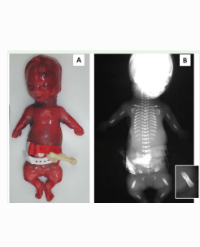
Skeletal Ciliopathies: The Fetal Phenotype and Genetic Correlates
Skeletal ciliopathies are inherited genetic skeletal dysplasias which result from defects in the biosynthesis and/or function of primary cilia. The predominant skeletal phenotype includes a narrow trunk with markedly or variably short ribs, and short limbs with or without polydactyly. Skeletal ciliopathies are commonly associated with particular extraskeletal malformations, variably including hindbrain malformations, corpus callosum agenesis, retinal, cardiovascular, gastrointestinal and genital abnormalities, and a particular spectrum of hepatorenal changes. The most severe among skeletal ciliopathies become manifest during fetal life and can be prenatally detected by ultrasound, leading to termination of pregnancy due to poor prognosis. The fetal skeletal ciliopathies are inherited in an autosomal recessive way, thus bearing a 25% recurrence risk in subsequent pregnancies, in contrast to the majority of fetal skeletal dysplasias which represent de novo mutations of autosomal dominant conditions with a very low recurrence risk. The phenotypic diagnosis is mainly based on the radiographic features in association with the external, visceral and histological findings at postmortem examination. In this article we review the fetal phenotype of the skeletal ciliopathies and provide a review of the ciliary mutations that have been associated with each entity.
Stylianos Velonis¹, Panagiotis Skaltsounis² and Anastasia E Konstantinidou²*
